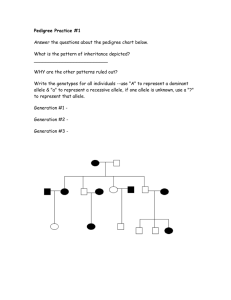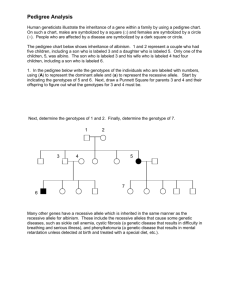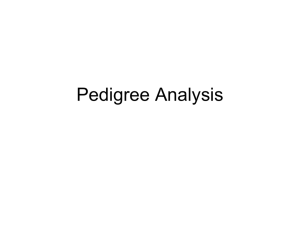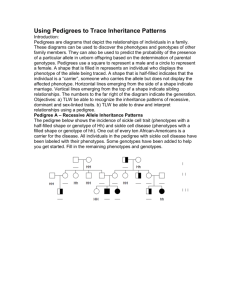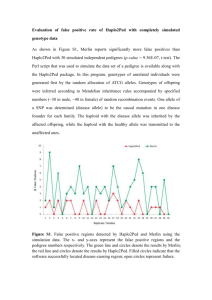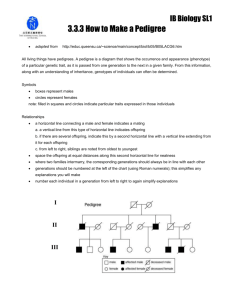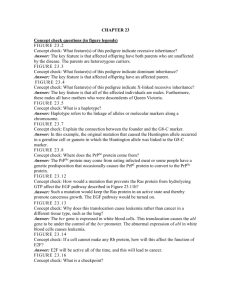Pedigree Practice Worksheet: Genetics Problems
advertisement
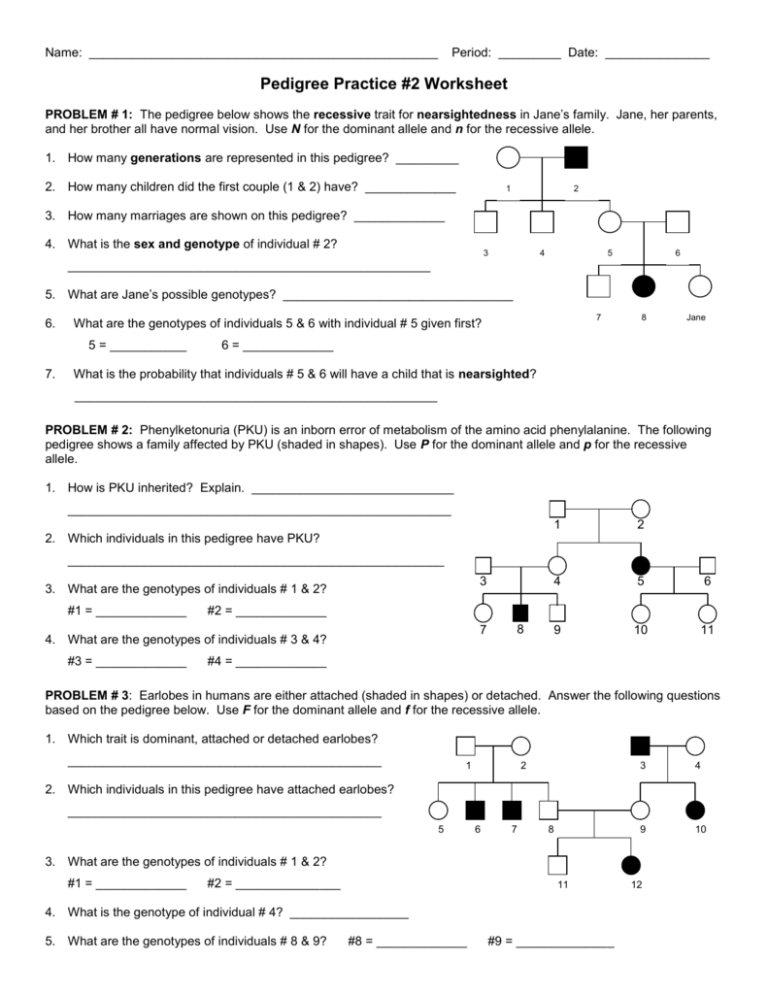
Name: __________________________________________________ Period: _________ Date: _______________ Pedigree Practice #2 Worksheet PROBLEM # 1: The pedigree below shows the recessive trait for nearsightedness in Jane’s family. Jane, her parents, and her brother all have normal vision. Use N for the dominant allele and n for the recessive allele. 1. How many generations are represented in this pedigree? _________ 2. How many children did the first couple (1 & 2) have? _____________ 1 2 3. How many marriages are shown on this pedigree? _____________ 4. What is the sex and genotype of individual # 2? 3 4 5 6 ____________________________________________________ 5. What are Jane’s possible genotypes? _________________________________ 6. 5 = ___________ 7. 7 What are the genotypes of individuals 5 & 6 with individual # 5 given first? 8 Jane 6 = _____________ What is the probability that individuals # 5 & 6 will have a child that is nearsighted? ____________________________________________________ PROBLEM # 2: Phenylketonuria (PKU) is an inborn error of metabolism of the amino acid phenylalanine. The following pedigree shows a family affected by PKU (shaded in shapes). Use P for the dominant allele and p for the recessive allele. 1. How is PKU inherited? Explain. _____________________________ _______________________________________________________ 1 2 4 5 6 9 10 11 2. Which individuals in this pedigree have PKU? ______________________________________________________ 3 3. What are the genotypes of individuals # 1 & 2? #1 = _____________ #2 = _____________ 7 4. What are the genotypes of individuals # 3 & 4? #3 = _____________ 8 #4 = _____________ PROBLEM # 3: Earlobes in humans are either attached (shaded in shapes) or detached. Answer the following questions based on the pedigree below. Use F for the dominant allele and f for the recessive allele. 1. Which trait is dominant, attached or detached earlobes? _____________________________________________ 1 2 3 4 9 10 2. Which individuals in this pedigree have attached earlobes? _____________________________________________ 5 6 7 8 3. What are the genotypes of individuals # 1 & 2? #1 = _____________ #2 = _______________ 11 4. What is the genotype of individual # 4? _________________ 5. What are the genotypes of individuals # 8 & 9? #8 = _____________ #9 = ______________ 12 Problem # 4: The following pedigree follows the inheritance of Huntington’s disorder (shaded in shapes) in a family. People afflicted with Huntington’s disorder do not show symptoms until they are about 35-40 years old. Use H for the dominant allele and h for the recessive allele. 1. Is Huntington’s disorder a Dominant or recessive trait? 1 _____________________________________________ 2 3 4 2. Which individuals in this pedigree have Huntington’s? _____________________________________________ 5 6 7 8 9 11 10 3. What is the genotype of individual # 1? _____________ 12 13 14 15 4. As a genetics counselor, suppose that individual # 14 and his wife seek advice about starting a family. What would you advise them regarding the probabilities in their children? _________________________________________________________________________________________________ PROBLEM # 5: This pedigree shows the typical inheritance pattern for Duchenne’s muscular dystrophy. Muscular dystrophy results in muscle weakness, progressive deterioration of muscle tissue, and loss of coordination. People with Duchenne’s muscular dystrophy rarely live past the age of 20. Use XD for the dominant allele, Xd for the recessive allele and Y for the male chromosome. 1. How is Duchenne’s muscular dystrophy inherited? ________________ 1 2 _________________________________________________________ 2. What are the genotypes of individuals # 1 & 2? 3 _________________________________________________________ 4 5 6 7 3. What are the genotypes of individuals # 3 & 4? _________________________________________________________ 8 9 10 11 4. What are the genotypes of individuals # 10 & 11? _________________________________________________________ 12 5. Suppose you are a genetics counselor. A married couple (# 3 & 4) seek advice from you as to whether or not they should have children. What would you advise and why? 13 14 15 _____________________________________________________________________________________________ _____________________________________________________________________________________________ PROBLEM # 6: This pedigree shows the typical inheritance of hemophilia, a sex-linked recessive disorder. Because their blood does not clot properly, people afflicted with hemophilia live to about 50 years old. Use XH for the dominant allele, Xh for the recessive allele, and Y for the male chromosome. 1. How is hemophilia inherited? ____________________________________ 1 ____________________________________________________________ 2 2. What are the genotypes of individuals # 2, 4, and 7? #2 = __________ #4 = __________ #7 = ___________ 4 3 5 6 7 3. What are the genotypes of individuals # 3, 6, and 8? #3 = __________ #6 = __________ #8 = ___________ 4. What is the probability that individual # 5 and an unaffected 8 9 10 11 12 male would have a son with hemophilia? _____________ What about have a daughter who is a carrier? _________ 13

